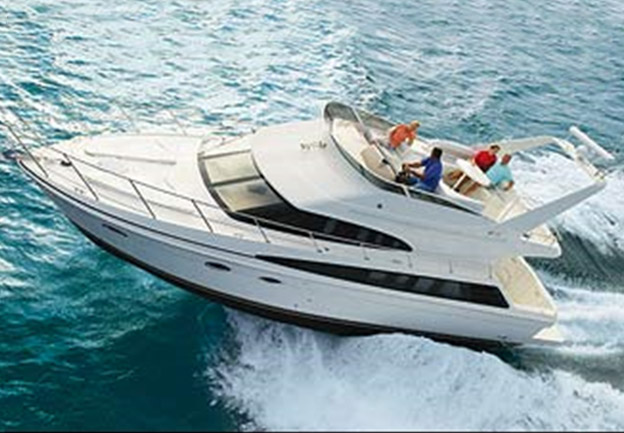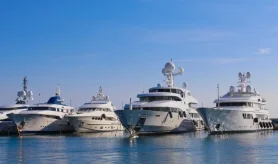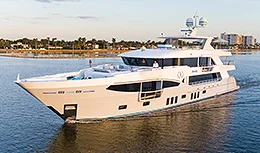- Alaskan Yachts
- Azimut Yachts
- Back Cove Yachts
- Beneteau Yachts
- Benetti Superyachts
- Bertram Yachts
- Boston Whaler
- Broward Yachts
- Buddy Davis Sportfish
- Burger Yachts
- Cabo Yachts
- Catamarans
- Carver Motoryachts
- Center Console
- Chris-Craft Yachts
- Cruisers Yachts
- DeFever Trawlers
- Dufour Sailboats
- Fairline Yachts
- Feadship Yachts
- Ferretti Yachts
- Filippetti Yachts
- Formula Yachts
- Fountaine Pajot Cats
- Grady-White
- Grand Banks Trawlers
- Hargrave Yachts
- Hatteras Yachts
- Hinckley Picnic Boats
- Horizon Yachts
- Hydra-Sports
- Intrepid Boats
- Jarrett Bay Sportfish
- Jeanneau Yachts
- Kadey-Krogen Trawlers
- Lazzara Yachts
- Lekker Boats
- Luhrs Sportfish
- Marlow Yachts
- Maritimo Yachts
- Marquis Yachts
- Mazu Yachts
- McKinna Motoryachts
- Meridian Yachts
- Midnight Express
- MJM Yachts
- Mochi Craft
- Neptunus Motoryachts
- Nordhavn Trawlers
- Nordic Tugs
- Numarine Yachts
- Ocean Alexander Yachts
- Ocean King
- Offshore Yachts
- Outer Reef
- Oyster Sailing Yachts
- Pacific Mariner Yachts
- Palmer Johnson Yachts
Boat Review: 42 Carver Super Sport 2006
Boat Review: 42 Carver Super Sport 2006

Yacht Review: 42 Carver Super Sport 2006
Source: Power&Motoryacht.com
Author: Capt. Patrick Sciacca
After testing Carver’s new 42 Super Sport powered by Volvo Penta’s Inboard Performance system (IPS), I was slackjaw. They’d harmonized like The Beach Boys on “Pet Sounds.”
I’ve always admired Carver’s ability to offer the cruising set commodious, home-like accommodations and an impressive list of standards across all of its 17 models. However, my personal experience with running its boats up to this day had been okay. I recall on one occasion wishing I had a more responsive wheel while making some hard-over turns, in addition to looking for a couple of more knots out of my test boat. And I’ve always thought that just because a boat is cruising-oriented doesn’t mean she can’t possess outstanding handling and get-up-and-go performance. I’m happy to report that after spending a day with this two-stateroom, two-head 42 on the back bays of Lake Worth, Florida, this launch has both of the aforementioned attributes and more.
With regards to performance, I recorded a 30-mph (26-knot) cruise speed at 3250 rpm with the optional ($90,785) Volvo Penta 370-hp IPS 500 diesels. And thanks in part to the harmonious workings, the 42’s fuel burn at cruise speed was relatively miserly at 33 gph. With 400 gallons of fuel available, the 42 can cruise speedily for 285 statute miles. If you want a little more wind in your hair (that is, if the optional bridge enclosure is open), just kick those diesels up to 3540 rpm (rated rpm is 3500), and try almost 35 mph at 41 gph. Aside from the impressive speed, the 42 popped out of the hole like an outboard-powered center console.
A lot has been written about the virtues of IPS technology, such as improved fuel efficiency, range, and speed, but it also offers something else: easy prop selection. That may not seem important, but propping boats often takes a lot of testing and tweaking. However, Volvo Penta developed a series of prop sets for IPS designated T2 through T10—no dimensions. Boatbuilders basically start with the smallest set (T2) and work their way up until the IPS engines are running at or near their rated rpm. In the case of my test boat, it was the T3s that did the trick. And while the boat ran just a hair more than rated rpm, it fell within accepted tolerances. As Randy Peterson, Carver’s propulsion and systems engineering manager, says, “They [Volvo Penta] have made it real simple for us.”
After putting my radar gun aside, I had to see and feel this for myself. The first thing I did was flip up the standard bolster seat at the port-side helm station, as I was planning on running this boat fast. However, even sitting at the helm, I found the sightlines clear in all directions. After taking note of an unobstructed path in front of me and with no boats coming up astern, I engaged the single-lever Volvo Penta electronic controls and throttled them full forward. The 42’s IPS engaged without a clunk. With minimal bow rise (I measured a maximum trim angle of 5 degrees), the 42 ran straight and true all the way to WOT. Peterson explained that Volvo Penta had experienced excessive bow rise on some express-cruiser models with IPS, but this was not the case with the 42. And thanks to the directional thrust provided by the drives, my test boat responded in a direct and deliberate manner. Her electronic steering, which at first felt like it was freewheeling, enabled me to turn this boat at speed within just a little more than her 43’7″ overall length.
Boat Specification: 42 Carver Super Sport 2006
Boat Type: Cruiser
Standard Power: 2/385-hp Crusader 8.1 MPI gasoline inboards
Optional Power: various twin gasoline and diesel inboards from Volvo Penta and Yanmar to 440 hp apiece; 2/370-hp Volvo Penta IPS 500 diesels with IPS drives
Length Overall (LOA): 43’7″
Beam: 13’11”
Draft: 3’10”
Weight: 33,650 lbs.
Fuel Capacity: 400 gal.
Water Capacity: 90 gal.
Standard Equipment: 3-zone, 35,000-Btu Marine Air A/C; Volvo Penta bow thruster (standard w/ Volvo Penta engines); 2/VacuFlush MSDs; flying-bridge wrap-around lounge, table, wet bar; tilt steering; transom door; telescoping boarding ladder; sapele pommele inlay on countertops and dinette table; cherrywood interior; solid cherry doors; 20″ Sole LCD TV w/ DVD, AM/FM stereo/CD; satellite radio; Black & Decker coffee maker; Tappan oven; 2-burner EuroKera electric cooktop; Nova Kool ‘fridge/freezer; L-shape dinette lounge; queen berth in forepeak master w/ pillowtop mattress; double berth in guest stateroom
Test Engines: 2/370-hp Volvo Penta IPS 500 diesels
Transmissions / Ratio: Volvo Penta/1.94:1
Props: T3 propset
Steering: Volvo Penta electronic
Controls: Volvo Penta single-lever electronic
Optional Equipment On Test Boat: oil-exchange system; Glendinning Cablemaster; 10-kW Kohler diesel genset; Raymarine electronics package; foredeck sunpad; helm and seat covers; central vacuum; side-by-side washer/dryer; 15″ Flexvision fold-down TV in master; Flexsteel sofa and double incliners
Conditions: temperature: 78º; humidity: 69%; wind: 5-10 mph; seas: calm; load: 400 gal. fuel, 0 gal. water, 4 persons, 500 lbs. gear. Speeds are two-way averages measured w/ Stalker radar gun. GPH measured w/ Volvo Penta electronic fuel-monitoring system. Range: 90% of advertised fuel capacity. Decibels measured on A scale. 65 dB is the level of normal conversation.



